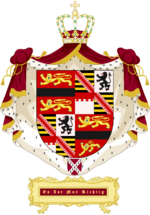House of Vethringen-Gerecht: Difference between revisions
mNo edit summary |
No edit summary |
||
| Line 44: | Line 44: | ||
}} | }} | ||
The '''House of Vethringen-Gerecht''', sometimes referred to as the '''House of Nachfolge''', is the house originated in 1623 after the conclusion of the [[Vethringen Succession War]] and the marriage of [[Wilhelm I, Duke of Lesser Vethringen]] to [[Claudia von Jostin-Saalten]]. Wilhelm I, claimed by the [[Nachfolgists]] to be the legitimate [[Archduchy of Vethringen|Archduke of Vethringen]], was the bastard son of [[Hans-Wilhelm II, Archduke of Vethringen|Hans-Wilhelm II]], the previous archduke, though Wilhelm claimed to have been legitimised by him prior to his death. As such, the succession was brought into question, and by the close of the Succession War, the [[Legitimists (Vethringen)|Legitimists]] held onto the [[Archduchy of Greater Vethringen|Archducal title]], and Wilhelm was reduced to a [[Duchy of Lesser Vethringen|Duke]]. By his marriage to [[Claudia von Jostin-Saalten]], Wilhelm aimed to cement his childrens' legitimacy by joining his house to a well-known and reasonably respected dynasty. Wilhelm called his new house the House of Vethringen-Gerecht, adopting as his motto a Nachfolgist motto from the war - "''[[Motto of Lesser Vethringen|es ist nur richtig]]''" - it is only right, referring to his aspirations of reclaiming the Archducal title from the [[House of Ausburg-Vethringen]]. | The '''House of Vethringen-Gerecht''', sometimes referred to as the '''House of Nachfolge''', is the house originated in 1623 after the conclusion of the [[Vethringen Succession War]] and the marriage of [[Wilhelm I, Duke of Lesser Vethringen]] to [[Claudia von Jostin-Saalten]]. Wilhelm I, claimed by the [[Nachfolgists]] to be the legitimate [[Archduchy of Vethringen|Archduke of Vethringen]], was the bastard son of [[Hans-Wilhelm II, Archduke of Vethringen|Hans-Wilhelm II]], the previous archduke, though Wilhelm claimed to have been legitimised by him prior to his death. As such, the succession was brought into question, and by the close of the Succession War, the [[Legitimists (Vethringen)|Legitimists]] held onto the [[Archduchy of Greater Vethringen|Archducal title]], and Wilhelm was reduced to a [[Duchy of Lesser Vethringen|Duke]]. By his marriage to [[Claudia von Jostin-Saalten]], Wilhelm aimed to cement his childrens' legitimacy by joining his house to a well-known and reasonably respected dynasty. Wilhelm called his new house the House of Vethringen-Gerecht, adopting as his motto a Nachfolgist motto from the war - "''[[Motto of Lesser Vethringen|es ist nur richtig]]''" - it is only right, referring to his aspirations of reclaiming the Archducal title from the [[House of Ausburg-Vethringen]]. | ||
The House of Vethringen-Gerecht is thus derived from a union of the houses of [[House of Vethringen|Vethringen]] and [[House of Jostin-Saalten|Jostin-Saalten]]. The House of Vethringen takes its name from the ancient [[Kingdom of Vethringen]] which existed from 509 until it swore fealty to ($STATE) in 730, forming the [[Archduchy of Vethringen]]. Vethringen itself derives its name from the [[Vetters]], a tribal confederation in the early Dolchic migrations. The first ruler of any Vethringian state to use the name "von Vethringen" as a noble house was [[Wilhelm II, Archduke of Vethringen]], whose dynasty, the [[Reinharding dynasty|Reinhardings]] had ruled Vethringen for 100 years prior after taking over from the [[Ottonid dynasty|Ottonids]]. | |||
Revision as of 01:40, 12 November 2021
| House of Vethringen-Gerecht House of Nachfolge | |
|---|---|
| Ducal House | |
 | |
| Parent family | House of Vethringen (agnatic) House of Jostin-Saalten (cognatic) |
| Country | Lesser Vethringen (Dolchland) |
| Etymology | From the Kingdom and later Archduchy of Vethringen. |
| Founded | 1623 |
| Founder | Wilhelm I, Duke of Lesser Vethringen |
| Current head | Wilhelm XIII, Duke of Lesser Vethringen |
| Titles | Dukes of Lesser Vethringen |
| Traditions | All heirs-apparent named Wilhelm. |
| Motto | (It is only right.) |
The House of Vethringen-Gerecht, sometimes referred to as the House of Nachfolge, is the house originated in 1623 after the conclusion of the Vethringen Succession War and the marriage of Wilhelm I, Duke of Lesser Vethringen to Claudia von Jostin-Saalten. Wilhelm I, claimed by the Nachfolgists to be the legitimate Archduke of Vethringen, was the bastard son of Hans-Wilhelm II, the previous archduke, though Wilhelm claimed to have been legitimised by him prior to his death. As such, the succession was brought into question, and by the close of the Succession War, the Legitimists held onto the Archducal title, and Wilhelm was reduced to a Duke. By his marriage to Claudia von Jostin-Saalten, Wilhelm aimed to cement his childrens' legitimacy by joining his house to a well-known and reasonably respected dynasty. Wilhelm called his new house the House of Vethringen-Gerecht, adopting as his motto a Nachfolgist motto from the war - "es ist nur richtig" - it is only right, referring to his aspirations of reclaiming the Archducal title from the House of Ausburg-Vethringen.
The House of Vethringen-Gerecht is thus derived from a union of the houses of Vethringen and Jostin-Saalten. The House of Vethringen takes its name from the ancient Kingdom of Vethringen which existed from 509 until it swore fealty to ($STATE) in 730, forming the Archduchy of Vethringen. Vethringen itself derives its name from the Vetters, a tribal confederation in the early Dolchic migrations. The first ruler of any Vethringian state to use the name "von Vethringen" as a noble house was Wilhelm II, Archduke of Vethringen, whose dynasty, the Reinhardings had ruled Vethringen for 100 years prior after taking over from the Ottonids.